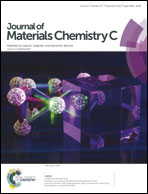Electronic properties of silicene superlattices: roles of degenerate perturbation and inversion symmetry breaking
Abstract
Using both the first-principles method and the tight-binding method, we have carried out detailed studies on the electronic properties of silicene superlattices. According to the band-folding picture, in the hexagonal silicene superlattice (M,N) when both M and N are integer multiples of 3, the simultaneous folding of K and K′ points to the Γ point results in the fourfold degeneracy. In the orthogonal one [P,Q], the fourfold degeneracy occurs if Q = 3q (q is an integer) is satisfied. By introducing degenerate perturbation to remove the fourfold degeneracy, the bandgap could be opened no matter whether the inversion symmetry remains or not. For the other cases, the bandgaps could be kept closed by the inversion symmetry preservation. Besides, the studied transport properties confirm the bandgap tuning by applying degenerate perturbation to the silicene superlattice. The new bandgap opening mechanism with degenerate perturbation could benefit further experimental studies of the silicene-based nanostructures for applications in nanoelectronics.


 Please wait while we load your content...
Please wait while we load your content...